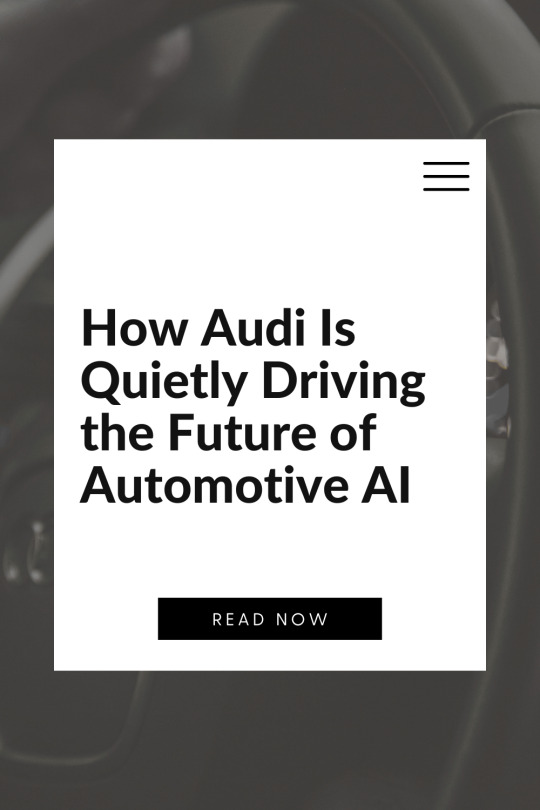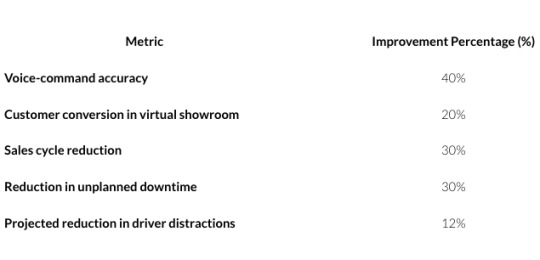#Business data tools
Explore tagged Tumblr posts
Text
📊 Still Just Using Bar Charts? Let Excel Do More of the Heavy Lifting.
You don’t need to be a data scientist to make smart, visual decisions — you just need to know how to make Excel work for you, not the other way around. 📈✨
This guide reveals the best practices for Excel data visualization in 2025 — from turning raw numbers into clear insights, to choosing the right chart (yes, there's a wrong one), and making your data talk.
🔗 Excel Data Visualization Secrets: Best Practices to Drive Smarter Decisions
If you want your spreadsheets to tell a story — not just spit out numbers — start here.

#Excel tips 2025#Data visualization guide#Charts in Excel#Make smarter decisions#Data storytelling#Excel dashboard hacks#Business data tools#Excel for analysts#Spreadsheets with impact#Visual data strategies
0 notes
Text

Artificial Intelligence is more than just a buzzword—it's a powerful force shaping the way we work, live, and connect. As businesses and professionals navigate the rapidly changing digital landscape, AI integration has become not only an advantage but a necessity. From automating repetitive tasks to streamlining communication, AI is transforming the workplace—and now is the time to plug in.
What Is AI Integration?
AI integration refers to the process of embedding intelligent technology into your current systems and workflows. Instead of replacing human effort, it enhances capabilities by analysing data, learning patterns, and optimising operations in real-time. For professionals and organisations alike, this means better decisions, faster execution, and improved customer experiences.
Why Embrace AI Today?
Here’s how AI integration is making a difference across industries:
Improved Efficiency
With AI handling time-consuming tasks like email filtering, data analysis, and scheduling, teams can focus on what truly matters—innovation and human connection.
Smarter Decisions
AI can process huge amounts of information quickly, offering insights that help businesses make better, data-backed choices.
Digital Strength
Today’s digital-first world demands a solid online presence. AI tools play a major role in Digital Presence Management, from optimising search visibility to curating consistent social media content.
Personal Branding
Professionals and entrepreneurs are increasingly using AI-powered personal branding tools to craft compelling bios, automate content creation, and engage with audiences more effectively.
B2B Strategy
In a competitive market, B2B branding strategy supported by AI helps teams personalise outreach, understand client behaviour, and build stronger relationships.
Getting Started With AI Integration
Adopting AI doesn’t require a tech overhaul. Start with tools you may already be using:
Leverage Smart Features: Google Workspace, Microsoft 365, and Canva now include AI suggestions, writing assistants, and design tools.
Automate with Purpose: Platforms like Zapier or Make.com allow easy automation between your favourite apps and services.
Explore Industry Tools: If you’re in marketing, explore ChatGPT or Jasper for content. If you’re in customer service, check out AI-enabled platforms like Intercom or Drift.
Best Practices for a Smooth Transition
Educate Your Team: Offer basic training so everyone feels confident using AI tools.
Start with a Small Project: Test out AI on a single workflow, such as automating social media or customer queries.
Maintain Human Oversight: Always review AI outputs for accuracy and relevance.
Key Takeaways
AI integration is no longer optional—it's essential. Whether you're looking to improve productivity, enhance brand visibility, or gain a competitive edge, integrating AI is a smart step forward.
Visit Best Virtual Specialist to discover how our expert virtual professionals can help you integrate AI tools, elevate your digital presence, and transform your workflow.
#Ai integration#Digital Presence Management#AI-Powered Personal Branding#B2B Branding Strategy#Artificial Intelligence#virtual specialist#business development strategy plan#data quality services#best virtual assistant in the usa#affordable va#outsourced va#aipoweredsupport#best admin assistant in australia#bpo admin support#ai tools#business support
3 notes
·
View notes
Text

AI’s Role in Business Process Automation
Automation has come a long way from simply replacing manual tasks with machines. With AI stepping into the scene, business process automation is no longer just about cutting costs or speeding up workflows—it’s about making smarter, more adaptive decisions that continuously evolve. AI isn't just doing what we tell it; it’s learning, predicting, and innovating in ways that redefine how businesses operate.
From hyperautomation to AI-powered chatbots and intelligent document processing, the world of automation is rapidly expanding. But what does the future hold?
What is Business Process Automation?
Business Process Automation (BPA) refers to the use of technology to streamline and automate repetitive, rule-based tasks within an organization. The goal is to improve efficiency, reduce errors, cut costs, and free up human workers for higher-value activities. BPA covers a wide range of functions, from automating simple data entry tasks to orchestrating complex workflows across multiple departments.
Traditional BPA solutions rely on predefined rules and scripts to automate tasks such as invoicing, payroll processing, customer service inquiries, and supply chain management. However, as businesses deal with increasing amounts of data and more complex decision-making requirements, AI is playing an increasingly critical role in enhancing BPA capabilities.
AI’s Role in Business Process Automation
AI is revolutionizing business process automation by introducing cognitive capabilities that allow systems to learn, adapt, and make intelligent decisions. Unlike traditional automation, which follows a strict set of rules, AI-driven BPA leverages machine learning, natural language processing (NLP), and computer vision to understand patterns, process unstructured data, and provide predictive insights.
Here are some of the key ways AI is enhancing BPA:
Self-Learning Systems: AI-powered BPA can analyze past workflows and optimize them dynamically without human intervention.
Advanced Data Processing: AI-driven tools can extract information from documents, emails, and customer interactions, enabling businesses to process data faster and more accurately.
Predictive Analytics: AI helps businesses forecast trends, detect anomalies, and make proactive decisions based on real-time insights.
Enhanced Customer Interactions: AI-powered chatbots and virtual assistants provide 24/7 support, improving customer service efficiency and satisfaction.
Automation of Complex Workflows: AI enables the automation of multi-step, decision-heavy processes, such as fraud detection, regulatory compliance, and personalized marketing campaigns.
As organizations seek more efficient ways to handle increasing data volumes and complex processes, AI-driven BPA is becoming a strategic priority. The ability of AI to analyze patterns, predict outcomes, and make intelligent decisions is transforming industries such as finance, healthcare, retail, and manufacturing.
“At the leading edge of automation, AI transforms routine workflows into smart, adaptive systems that think ahead. It’s not about merely accelerating tasks—it’s about creating an evolving framework that continuously optimizes operations for future challenges.”
— Emma Reynolds, CTO of QuantumOps
Trends in AI-Driven Business Process Automation
1. Hyperautomation
Hyperautomation, a term coined by Gartner, refers to the combination of AI, robotic process automation (RPA), and other advanced technologies to automate as many business processes as possible. By leveraging AI-powered bots and predictive analytics, companies can automate end-to-end processes, reducing operational costs and improving decision-making.
Hyperautomation enables organizations to move beyond simple task automation to more complex workflows, incorporating AI-driven insights to optimize efficiency continuously. This trend is expected to accelerate as businesses adopt AI-first strategies to stay competitive.
2. AI-Powered Chatbots and Virtual Assistants
Chatbots and virtual assistants are becoming increasingly sophisticated, enabling seamless interactions with customers and employees. AI-driven conversational interfaces are revolutionizing customer service, HR operations, and IT support by providing real-time assistance, answering queries, and resolving issues without human intervention.
The integration of AI with natural language processing (NLP) and sentiment analysis allows chatbots to understand context, emotions, and intent, providing more personalized responses. Future advancements in AI will enhance their capabilities, making them more intuitive and capable of handling complex tasks.
3. Process Mining and AI-Driven Insights
Process mining leverages AI to analyze business workflows, identify bottlenecks, and suggest improvements. By collecting data from enterprise systems, AI can provide actionable insights into process inefficiencies, allowing companies to optimize operations dynamically.
AI-powered process mining tools help businesses understand workflow deviations, uncover hidden inefficiencies, and implement data-driven solutions. This trend is expected to grow as organizations seek more visibility and control over their automated processes.
4. AI and Predictive Analytics for Decision-Making
AI-driven predictive analytics plays a crucial role in business process automation by forecasting trends, detecting anomalies, and making data-backed decisions. Companies are increasingly using AI to analyze customer behaviour, market trends, and operational risks, enabling them to make proactive decisions.
For example, in supply chain management, AI can predict demand fluctuations, optimize inventory levels, and prevent disruptions. In finance, AI-powered fraud detection systems analyze transaction patterns in real-time to prevent fraudulent activities. The future of BPA will heavily rely on AI-driven predictive capabilities to drive smarter business decisions.
5. AI-Enabled Document Processing and Intelligent OCR
Document-heavy industries such as legal, healthcare, and banking are benefiting from AI-powered Optical Character Recognition (OCR) and document processing solutions. AI can extract, classify, and process unstructured data from invoices, contracts, and forms, reducing manual effort and improving accuracy.
Intelligent document processing (IDP) combines AI, machine learning, and NLP to understand the context of documents, automate data entry, and integrate with existing enterprise systems. As AI models continue to improve, document processing automation will become more accurate and efficient.
Going Beyond Automation
The future of AI-driven BPA will go beyond automation—it will redefine how businesses function at their core. Here are some key predictions for the next decade:
Autonomous Decision-Making: AI systems will move beyond assisting human decisions to making autonomous decisions in areas such as finance, supply chain logistics, and healthcare management.
AI-Driven Creativity: AI will not just automate processes but also assist in creative and strategic business decisions, helping companies design products, create marketing strategies, and personalize customer experiences.
Human-AI Collaboration: AI will become an integral part of the workforce, working alongside employees as an intelligent assistant, boosting productivity and innovation.
Decentralized AI Systems: AI will become more distributed, with businesses using edge AI and blockchain-based automation to improve security, efficiency, and transparency in operations.
Industry-Specific AI Solutions: We will see more tailored AI automation solutions designed for specific industries, such as AI-driven legal research tools, medical diagnostics automation, and AI-powered financial advisory services.
AI is no longer a futuristic concept—it’s here, and it’s already transforming the way businesses operate. What’s exciting is that we’re still just scratching the surface. As AI continues to evolve, businesses will find new ways to automate, innovate, and create efficiencies that we can’t yet fully imagine.
But while AI is streamlining processes and making work more efficient, it’s also reshaping what it means to be human in the workplace. As automation takes over repetitive tasks, employees will have more opportunities to focus on creativity, strategy, and problem-solving. The future of AI in business process automation isn’t just about doing things faster—it’s about rethinking how we work all together.
Learn more about DataPeak:
#datapeak#factr#technology#agentic ai#saas#artificial intelligence#machine learning#ai#ai-driven business solutions#machine learning for workflow#ai solutions for data driven decision making#ai business tools#aiinnovation#digitaltools#digital technology#digital trends#dataanalytics#data driven decision making#data analytics#cloudmigration#cloudcomputing#cybersecurity#cloud computing#smbs#chatbots
2 notes
·
View notes
Text
10 Ways Technology is Boosting Workplace Productivity
In the contemporary professional landscape, productivity is the currency of success. Businesses and individuals alike are constantly seeking innovative strategies to optimize output, streamline workflows, and maximize efficiency. At the forefront of this revolution is technology, which has fundamentally transformed how we work, collaborate, and manage our time. Far from being a mere convenience,…
#AI in Workplace#artificial intelligence#automation#business efficiency#Business Growth#Business Intelligence#Business Management#Business Solutions#Business Technology#cloud computing#Collaboration Tools#cybersecurity#data analytics#Data-Driven Decisions#Digital Collaboration#Digital Document Management#digital tools#digital transformation#Digital Workplace#Efficiency Tools#Employee Efficiency#Employee Engagement Technology#Employee Training Platforms#Enterprise Software#future of work#Hybrid Work#machine learning#Mobile Productivity#Modern Workplace#Office Technology
1 note
·
View note
Text
Top 5 DeepSeek AI Features Powering Industry Innovation
Table of Contents1. The Problem: Why Legacy Tools Can’t Keep Up2. What Makes DeepSeek AI Unique?3. 5 Game-Changing DeepSeek AI Features (with Real Stories)3.1 Adaptive Learning Engine3.2 Real-Time Anomaly Detection3.3 Natural Language Reports3.4 Multi-Cloud Sync3.5 Ethical AI Auditor4. How These Features Solve Everyday Challenges5. Step-by-Step: Getting Started with DeepSeek AI6. FAQs: Your…
#affordable AI solutions#AI automation#AI for educators#AI for entrepreneurs#AI for non-techies#AI for small business#AI in manufacturing#AI innovation 2024#AI time management#business growth tools#data-driven decisions#DeepSeek AI Features#ethical AI solutions#healthcare AI tools#no-code AI tools#Predictive Analytics#real-time analytics#remote work AI#retail AI features#startup AI tech
2 notes
·
View notes
Text
🌟 Unlock Business Insights with the Contact Info Scraper 🌟
Looking for a powerful, efficient tool to extract accurate business contact information? Meet the Contact Info Scraper by Dainty Screw on Apify. 🚀
💡 What It Does:
• Extract business emails, phone numbers, addresses, and more from websites.
• Perfect for building targeted outreach lists, lead generation, or enhancing your marketing campaigns.
• Works seamlessly with dynamic and static websites.
📈 Why Choose This Scraper?
• Fast & Accurate: Saves you hours of manual data collection.
• User-Friendly: Easy-to-use interface, even for non-techies.
• Customizable: Tailor the scraper to meet your unique business needs.
🔧 Who Can Benefit?
• Marketers: Boost your outreach campaigns.
• Entrepreneurs: Build B2B connections with ease.
• Freelancers: Gather leads for your clients in no time.
🌐 Start scraping smarter today! Try it now and take your business to the next level.
👉 Check it out here: Contact Info Scraper on Apify
💻 Need Custom Automations? Contact us to build your dream scraper.
#DataScraping #BusinessGrowth #AutomationTools #LeadGeneration #Apify
3 notes
·
View notes
Text

Decode the world of finance with BiCXO. Today’s term: Derivatives
Visit our website by clicking on the Image.
#BiCXO#learnfinancewithBiCXO#BusinessIntelligenceTools#BusinessSuccess#financeleaders#financeprofessionals#Derivatives#WordOfTheWeek#business solutions#business intelligence#business intelligence software#bi tool#bisolution#businessintelligence#data#businessefficiency#derivation#finance tips
2 notes
·
View notes
Text
Top 5 Benefits of Low-Code/No-Code BI Solutions
Low-code/no-code Business Intelligence (BI) solutions offer a paradigm shift in analytics, providing organizations with five key benefits. Firstly, rapid development and deployment empower businesses to swiftly adapt to changing needs. Secondly, these solutions enhance collaboration by enabling non-technical users to contribute to BI processes. Thirdly, cost-effectiveness arises from reduced reliance on IT resources and streamlined development cycles. Fourthly, accessibility improves as these platforms democratize data insights, making BI available to a broader audience. Lastly, agility is heightened, allowing organizations to respond promptly to market dynamics. Low-code/no-code BI solutions thus deliver efficiency, collaboration, cost savings, accessibility, and agility in the analytics landscape.
#newfangled#polusai#etl#nlp#data democratization#business data#big data#ai to generate dashboard#business dashboard#bi report#generativeai#business intelligence tool#artificialintelligence#machine learning#no code#data analytics#data visualization#zero coding
3 notes
·
View notes
Text
Location Intelligence Sri Lanka,
Why Location Intelligence?
https://geosciences.advintek.com.sg/wp-content/uploads/2024/10/analytics.png
Unmatched Analytical Power
Location Intelligence enables advanced analytics that reveals patterns and trends in your data, allowing you to identify opportunities and risks in real-time. By leveraging spatial data, businesses can uncover hidden insights that lead to more informed strategic decisions.

Actionable Insights
Turn complex geospatial data into actionable insights with intuitive visualization tools that help stakeholders grasp key information quickly and make informed decisions. With clear visual representations of data, teams can collaborate more effectively and align their strategies for optimal results.

Cost Optimization
Identify inefficiencies in your operations, such as excess inventory or underutilized assets, and leverage insights to optimize resource allocation and reduce costs. This strategic approach to resource management not only saves money but also enhances overall operational efficiency.

Seamless Data Integration
Effortlessly integrate diverse datasets from various sources, such as CRM systems, GIS platforms, and business intelligence tools, for a comprehensive view of your operations. This holistic perspective enhances your understanding of market dynamics and customer behavior, enabling more effective decision-making.
Get in Touch with us
Location
7 Temasek Boulevard, #12-07, Suntec Tower One, Singapore 038987
Email Address
Phone Number
+65 6428 6222
#Location Intelligence#Geospatial Analytics#GIS Solutions#Spatial Data Insights#Location-Based Decision Making#Business Mapping Tools#Real-Time Location Data#Address Intelligence#Geospatial Technology#Location Intelligence Platform#Smart City Solutions
0 notes
Text
Unlock Data Insights: The Proven Performance of SQL Server Standard 2017
Harnessing the Power of SQL Server Standard 2017 for Business Success
In today’s data-driven world, unlocking valuable insights from your data can set your business apart from the competition. SQL Server Standard 2017 stands out as a robust and reliable platform that empowers organizations to analyze, manage, and utilize their data effectively. Its proven performance capabilities and comprehensive features make it an essential tool for businesses aiming to harness the full potential of their data assets.
One of the key advantages of SQL Server Standard 2017 is its high performance and scalability, which allows businesses to handle large volumes of data with ease. Whether you're managing small databases or enterprise-level data warehouses, SQL Server 2017 is designed to deliver consistent, fast results. Its in-memory capabilities and advanced query processing enable faster data retrieval and analysis, saving valuable time and resources.
Beyond raw performance, SQL Server Standard 2017 offers a suite of built-in tools for data analysis and business intelligence. Features like SQL Server Analysis Services (SSAS), Reporting Services (SSRS), and Integration Services (SSIS) facilitate comprehensive data modeling, reporting, and integration. These tools enable organizations to create insightful dashboards, reports, and data workflows that support informed decision-making at all levels.
Security and reliability are paramount in data management, and SQL Server Standard 2017 excels in these areas. With features such as built-in encryption, robust authentication, and auditing, businesses can ensure their data remains protected against threats. Additionally, its high availability and disaster recovery options guarantee minimal downtime, maintaining business continuity even in challenging situations.
Implementing SQL Server Standard 2017 can significantly enhance your data infrastructure, especially for small to medium-sized businesses seeking enterprise-grade solutions without the hefty price tag. Its flexible licensing options and ease of integration with existing systems make it a practical choice for organizations looking to optimize their data operations.
If you are ready to elevate your data capabilities and unlock actionable insights, consider investing in SQL Server Standard 2017. You can buy sql server 2017 standard license today and start transforming your data into a strategic asset that drives growth and innovation.
#sql server 2017 performance#data analytics with sql server#reliable database management#SQL Server Standard features#business intelligence tools#enterprise data solutions
0 notes
Text
Business IT Solution for Digital Transformation Success
Modern leaders must act fast because change never slows. Moreover, IT solutions for business now shape every growth plan. As digital tools take over daily work, every business must adopt the right strategy to stay ahead. From cloud systems to data protection, smart moves make a big difference . Small steps bring big results when paired with a clear vision. Digital transformation is not just a tech shift—it is a cultural shift. Therefore, success depends on smart planning, strong support, and the right tools. This post shows clear steps, simple tools, and steady wins that let any firm thrive.
Why a Business IT Solution Drives Continuous Value
However, every market shifts daily, and data grows hourly. Therefore, a Business IT Solution guides teams, aligns systems, and cuts waste. Moreover, clear dashboards reveal gaps; thus, leaders adjust in time. Consequently, profits rise while risks fall.
Business IT Solution for Cloud Adoption
Furthermore, cloud shifts the cost from capital to usage. Hence, teams pay only for real demand. Because of this, apps scale during peaks and shrink during dips. Consequently, users enjoy smooth service without extra spending.
#business IT solutions#digital transformation#IT strategy#cloud adoption#secure data#system integration#agile methods#data-driven decisions#technology for business#IT for growth#business innovation#digital tools#IT support#enterprise technology#process automation.
0 notes
Text
Smart Marketing Starts Here: Why More Brands Trust Service Zoom for Digital Growth

Presented by Service Zoom Marketing
In today’s fast-paced digital marketplace, having a great product or service isn’t enough. You need smart marketing strategies that cut through the noise, drive conversions, and grow your brand across multiple channels.
That’s exactly what we deliver at Service Zoom Marketing — where innovation meets execution to help you scale with confidence.
1. One Agency. All the Tools You Need.
Forget juggling multiple vendors. Service Zoom is your one-stop digital growth partner offering:
SEO for Google visibility
Web & app development to build your digital foundation
Social media marketing (SMM) for daily engagement and leads
Google & Meta Ads for high-ROI paid campaigns
Graphic design & content creation to elevate your brand
We create integrated digital ecosystems that deliver results across every touchpoint.
Explore all our services here
2. Social Media that Works — Not Just Looks
Likes and followers are only the beginning. We build high-performance social media strategies that:
Attract the right audience
Drive brand awareness and lead generation
Convert traffic into sales
Build lasting customer relationships
Whether you're on Instagram, Facebook, LinkedIn, or TikTok, we help you show up strategically, consistently, and creatively.
3. Paid Ads with Powerful ROI
Why gamble with your ad budget? Our Google and Meta ad experts create laser-targeted campaigns that bring in:
More qualified leads
Increased eCommerce conversions
Lower cost per click (CPC)
Better return on investment (ROI)
With us, your ads don’t just run — they work smarter.
Get expert PPC management now
4. Websites That Sell — Not Just Look Good
We design fast, mobile-friendly websites that are:
SEO-optimized
UX-focused
Conversion-ready
Whether you need an e-commerce platform, business site, or custom web application — we build to scale.
Check out our web development services
5. Why Brands Choose Service Zoom
Personalized attention from digital experts
Transparent reporting & analytics
Quick turnaround time
End-to-end digital support
Proven track record with small businesses & enterprise clients
We don’t just deliver services. We build partnerships that fuel long-term growth.
Ready to Go from Surviving to Scaling?
Whether you're launching a new business or leveling up an existing one, Service Zoom Marketing has the digital solutions you need to stand out and succeed.
Let’s build your growth roadmap — Get started today
#Service Zoom digital marketing#Smart marketing solutions#Digital growth strategies#Marketing automation tools#Brand growth with Service Zoom#Social media marketing software#Service Zoom for businesses#Scalable marketing platform#All-in-one marketing solution#Service Zoom for digital success#Business marketing tools#Brand trust digital tools#Online customer engagement#Data-driven marketing#Marketing software for small business#Boost brand visibility#Marketing platform for growth#Trusted marketing software#Digital tools for brand growth#Grow your brand online
0 notes
Text

How Audi Is Quietly Driving the Future of Automotive AI
Artificial intelligence has become the engine powering the most transformative changes across virtually every industry. For the automotive world, the shift is especially profound. AI is steering the automotive world toward smarter manufacturing, safer roads, and deeply personalized driving. Among the most visionary companies leading this charge is Audi. From its ultra-modern “AI-native” factories to advanced in-car intelligence, Audi offers a compelling blueprint for leveraging AI at every stage of the vehicle lifecycle.
Not Just Autonomous Driving
While the media often focuses on self-driving cars, Audi's AI strategy extends far beyond that. Sure, the company has made notable advancements in autonomous systems (like its now-retired Traffic Jam Pilot), but the real innovation is what lies beneath the surface: the ecosystems supporting these features.
Audi’s contribution to the open-source A2D2 (Audi Autonomous Driving Dataset) provides a rare look at the data complexity involved in perception modeling. Over 40,000 frames of LIDAR, radar, and camera sensor fusion data are helping both Audi and researchers develop safer, smarter autonomous navigation systems.
But Audi isn’t betting solely on self-driving; instead, it's engineering intelligence into every layer of mobility. From predictive systems that learn your driving habits, to AI-enhanced safety systems that interpret and anticipate road behaviour, to dynamic route recommendations based on real-time traffic, weather, and even driver moods.

Inside the Most Advanced AI Factory You've Never Heard About
Where Audi truly breaks new ground is within its factories, particularly at its Neckarsulm and Ingolstadt plants. Here, the company is pioneering what could be the automotive industry's most sophisticated AI-integrated manufacturing environments. These aren’t just smart factories, they’re learning factories that continuously evolve and improve.
At the Neckarsulm facility, machine learning systems analyze over 100 different parameters from spot welding machines. Rather than relying on manual inspections, the AI monitors weld quality in real time, efficiently flagging only the anomalies that require attention. This targeted approach minimizes downtime and reduces human error.
Meanwhile, at Ingolstadt, cutting-edge computer vision algorithms paired with ultra-high-resolution cameras perform detailed inspections of sheet metal. These AI-driven systems detect cracks and deformations far earlier than human inspectors could, allowing for preventative action before defects escalate.
Unlike traditional automation, which simply follows fixed instructions, Audi’s AI models continuously adapt by learning from factors such as:
Wear and tear on machinery
Variations in raw materials
Changes in ambient temperature and environmental conditions
This dynamic adaptability not only saves valuable time and reduces material waste but also ensures a level of consistent quality that far exceeds what manual processes alone can achieve.
Rethinking Production at Scale
Audi’s AI25 initiative, in collaboration with Fraunhofer Institutes, goes even deeper. It turns production environments into dynamic data ecosystems. One of the most intriguing innovations is the use of VR-powered workshops, where planning engineers wear goggles to simulate and test assembly line changes in a digital twin of the real factory. They can spot inefficiencies, redesign workflows, and improve ergonomics without halting a single conveyor belt.
Add to this smart glasses used in logistics centers, which track eye movements to optimize inventory placement and retrieval. Then consider the on-demand 3D printing systems that build custom tools tailored to an individual worker’s task or even physical build. This is not just efficiency; it's human-centered AI, giving employees more agency, not less.
Predictive Maintenance: Saving Millions by Avoiding Downtime
One of the most underappreciated uses of AI in the automotive world is predictive maintenance. At Audi, AI monitors vehicle data to forecast mechanical issues before they occur, not just for the driver, but also for the machines that build the cars.
On the factory floor, Audi’s systems monitor temperature, vibration, cycle speed, and torque in real-time. When the AI detects a potential deviation from the norm, it schedules a preemptive check. This reduces unplanned downtime by 30% or more, saving over €10 million annually.
Similarly, AI embedded in Audi vehicles alerts drivers to service needs, optimizing repair intervals and improving resale value. This proactive model improves both customer satisfaction and internal logistics.
AI Meets the Driver
Audi doesn’t just apply AI to manufacturing, it personalizes the driving experience in subtle but powerful ways. Through its adaptive MMI (Multi Media Interface), AI continuously learns a driver’s habits and preferences, including:
Climate control settings
Frequent destinations
Seat position
Over time, the system can anticipate your needs even before you voice them.
Natural language processing (NLP) has also matured significantly in Audi’s vehicles. The voice assistant now understands context, not just commands. For example, if you say, “I’m cold,” the car will automatically adjust the temperature instead of simply replying with confusion.
These voice interactions are part of a learning system that becomes increasingly attuned to individual drivers. According to Audi:
More than 60% of users engage with personalized settings weekly
Voice-command accuracy has improved by over 40% since implementing deep-learning-based NLP
The system currently handles over 200 distinct command types
Internal usability tests project a reduction in driver distraction incidents by up to 12%
This personalization goes beyond the cockpit. The myAudi app connects the vehicle to the cloud, creating a complete digital twin of the car. This seamless integration includes:
Maintenance alerts
Service logs
Driving behavior analytics
Together, these data streams lay the foundation for next-level services such as:
Predictive navigation
Energy usage coaching
Personalized insurance models tailored to individual driving styles and habits
“AI isn’t just about self-driving cars for us. It’s about enhancing every part of the vehicle experience; from how it’s built to how it learns your habits behind the wheel.”
— Markus Vogel, Head of AI Integration at Audi
Selling the Experience Before the Car
The application of AI at Audi goes well beyond engineering. It plays a pivotal role in reshaping the brand’s retail and marketing strategy. Virtual showrooms powered by AI allow customers to configure their ideal vehicles in immersive augmented reality environments. These experiences are not only engaging but also data-rich and seamless, reducing time-to-purchase while boosting buyer confidence. In fact, Audi’s virtual showroom technology has led to a 20% increase in customer conversion rates and a 30% reduction in the average sales cycle.
Behind the scenes, Audi leverages AI to analyze customer behaviour, anticipate market trends, and target potential buyers with exceptional precision. Instead of relying on broad, generic outreach, Audi deploys personalized marketing campaigns grounded in real-time engagement and individual product interest. With AI-enhanced product configuration and behaviour-driven recommendations, prospective buyers aren’t just browsing, they’re making decisions more quickly, and with greater certainty.
What Sets Audi Apart
Many automakers are exploring AI, but Audi's approach is distinct. It isn’t chasing headlines with moonshot ideas. Instead, it builds methodically, applying AI in ways that create tangible value: fewer errors, safer processes, better products, and more intuitive experiences.
Unlike rivals who may bolt AI onto isolated functions, Audi weaves intelligence into the entire lifecycle of its vehicles. This is vertical integration, reimagined for the data age. From raw material inspection to customer support, AI is not a side project at Audi, it has become the foundation for everything.
Visual Graph: Improvements Due to AI Implementation

Industry Implications & the Human Element
Audi’s strategy offers a roadmap not just for automakers, but for any enterprise looking to scale AI effectively. It highlights the importance of internal education, cross-functional collaboration, and ethical foresight. Every technological rollout includes change management, workforce upskilling, and transparency.
Audi doesn’t treat AI as a replacement for humans but as an enhancer. Employees are trained to work alongside AI systems, interpreting their outputs and intervening when needed. The result is not just a more efficient company but a more resilient one.
AI Transforming the Automotive Industry Altogether
The implications of Audi’s AI initiatives ripple far beyond the brand itself. As AI technologies mature, they are redefining what it means to manufacture, sell, and drive a vehicle. Competitors are watching closely, emulating Audi’s playbook, particularly in areas like production efficiency and personalized customer experiences.
Industry-wide, AI is ushering in a new era of modular, flexible manufacturing systems, replacing rigid assembly lines with adaptive, data-driven processes. This shift offers clear advantages:
Reduced lead times and production costs
Faster innovation cycles
Real-time adaptability to shifting consumer demands or supply chain disruptions, which is a level of responsiveness that was nearly impossible a decade ago
At the same time, AI is accelerating the move toward electric and sustainable mobility. Its capabilities directly contribute to lowering carbon footprints by:
Optimizing battery production
Managing energy flows across systems
Predicting component wear to reduce waste and improve longevity
From supply chains to steering wheels, AI is embedding intelligence into the entire automotive value chain. This convergence of technology and mobility is laying the foundation for a truly connected future, where vehicles become active participants in a dynamic digital ecosystem that is constantly learning, adapting, and improving.
Through it all, Audi’s systematic and intentional approach to AI stands out. Rather than chasing headlines, Audi focuses on:
Integration over experimentation
Utility over novelty
Audi’s systematic, grounded application of AI is setting the standard for the automotive industry. By focusing on integration rather than experimentation, utility rather than novelty, Audi is creating something more sustainable: a smarter company for a smarter future. In doing so, it shows us that the future of mobility won’t arrive with a bang. It will arrive with data, algorithms, and quiet revolutions, just like the one Audi is already leading.
Learn more about DataPeak:
#datapeak#factr#saas#technology#agentic ai#machine learning#artificial intelligence#ai#ai-driven business solutions#machine learning for workflow#dataanalytics#data driven decision making#data analytics#digitaltools#digital technology#digital trends#intelligence artificielle#artificialintelligence#ai business tools#ai agents#aiinnovation
0 notes
Text
Ultimate Guide to DeepSeek AI for Business Growth
Table of Contents of DeepSeek AI for Business Growth1. Introduction: Why AI is Essential for Modern Business Growth2. What Is DeepSeek AI?3. Top 5 DeepSeek AI Tools for Scaling Businesses3.1 Demand Forecasting Engine3.2 Customer Lifetime Value (CLV) Predictor3.3 Automated Supply Chain Optimizer3.4 Dynamic Pricing Module3.5 Sentiment Analysis Hub4. How DeepSeek AI Reduces Costs and Boosts…
#AI automation 2024#AI budgeting#AI business growth#AI for non-tech teams#AI for startups#AI implementation guide#AI in retail#AI supply chain#Business Intelligence#cost reduction strategies#data-driven decisions#DeepSeek AI#enterprise AI adoption#fintech AI solutions#generative AI for business#Predictive Analytics#ROI optimization#scaling with AI#SME AI tools#startup scaling
2 notes
·
View notes
Text

Unlock powerful decision-making with MindCoders’ Data Analytics Course! Gain hands-on expertise in SQL, Python, R, Tableau/Power BI, statistical modeling, and data storytelling through real-world projects. Demand for analytics professionals is surging—businesses across finance, healthcare, e-commerce, and more rely on data insights to drive innovation and efficiency . Equip yourself with in-demand skills to analyze complex datasets, visualize trends, and deliver actionable business outcomes—future-proofing your career in one of the fastest-growing global fields
#data analytics#business intelligence#data visualization#predictive analytics#big data analytics#data mining#machine learning#data warehousing#data analysis tools#data-driven decision making
0 notes
Text
How KPI dashboards revolutionize financial decision-making

Importance of KPI Dashboards in Financial Decision-Making
With technological advancements, Key Performance Indicator (KPI) dashboards have reshaped how companies handle financial data, fostering a dynamic approach to managing financial health.
Definition and Purpose of KPI Dashboards
KPI dashboards are interactive tools that present key performance indicators visually, offering a snapshot of current performance against financial goals. They simplify complex data, enabling quick assessment and response to financial trends.
Benefits of Using KPI Dashboards for Financial Insights
KPI dashboards provide numerous advantages:
Real-Time Analytics: Enable swift, informed decision-making.
Trend Identification: Spot trends and patterns in financial performance.
Data-Driven Decisions: Ensure decisions are based on accurate data, not intuition.
Data Visualization Through KPI Dashboards
The power of KPI dashboards lies in data visualization, making complex information easily understandable.
Importance of Visual Representation in Financial Data Analysis
Visuals enable rapid comprehension and facilitate communication of complex financial information across teams and stakeholders.
Key Performance Metrics for Financial Decision-Making
Key performance metrics (KPIs) provide an overview of a company’s financial situation and forecast future performance. Key metrics include:
Revenue and Profit Metrics:
Net Profit Margin: Measures net income as a percentage of revenue.
Gross Profit Margin: Highlights revenue exceeding the cost of goods sold.
Annual Recurring Revenue (ARR) and Monthly Recurring Revenue (MRR): Important for subscription-based businesses.
Cash Flow Metrics:
Operating Cash Flow (OCF): Reflects cash from operations.
Free Cash Flow (FCF): Measures cash after capital expenditures.
Cash Conversion Cycle (CCC): Provides insight into sales and inventory efficiency.
ROI and ROE Metrics:
Return on Investment (ROI): Measures gain or loss on investments.
Return on Equity (ROE): Assesses income from equity investments.
Successful Integration of KPI Dashboards
An MNC uses a custom KPI dashboard to track financial metrics, enabling strategic pivots and improved financial forecasting, leading to significant growth.
Best Practices for Using KPI Dashboards in Financial Decision-Making
Setting Clear Objectives and Metrics: Align KPIs with clear goals.
Ensuring Data Accuracy and Integrity: Implement data validation.
Regular Monitoring and Evaluation: Actively track progress and adapt KPIs as needed.
Future Trends in KPI Dashboards for Financial Decision-Making
Predictive analytics, forecasting, and AI integration are transforming KPI dashboards, enabling proactive and strategic financial decision-making.
KPI dashboards revolutionize financial decision-making by providing real-time, accessible, and visually compelling information. They democratize data and align efforts with strategic goals, making them indispensable for modern business leaders.
This was just a snippet if you want to read the detailed blog click here
#business solutions#business intelligence#business intelligence software#bi tool#bisolution#businessintelligence#bicxo#businessefficiency#data#kpi#kpidashboards#decisionmaking
1 note
·
View note